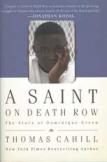A Solitary Life
Thomas Cahill has interrupted his series on “the hinges of history” to present an inspiring example of human development on death row. Dominique Green, a young black man who grew up on the streets of Houston, was cared for by his mother for a few brief years before she fell victim to drugs and violence. Partly to support his younger brothers, he began to sell drugs regularly. When he was 18, Dominique and three others took part in an armed robbery during which Andrew Lastrapes, an African-American truck driver, was shot dead. The white man who was part of the group was never punished; two African-Americans got prison sentences. Charged with capital murder, Dominique was convicted in 1993 and executed by lethal injection in 2004.
Cahill shows us the indifference of the young man’s lawyers and the callousness and incompetence of Texas criminal justice. More important, he helps us see how Dominique grew intellectually and spiritually under the eye of death. He not only trained himself in the intricacies of law, but read Archbishop Desmond Tutu’s No Future Without Forgiveness and communicated its spirit to fellow prisoners awaiting execution.
In his effort to reach out and make friends, Dominique wrote letters to editors, including one published in an Italian paper in 1995. This came to the attention of a young female member of the community of Sant’Egidio, a dynamic Italian (now international) group that grew out of the student protests in the 1960s and tried to follow Jesus’ command to love our neighbor. The young woman could offer friendship only from afar, but others in the community became interested, and an older member engaged a retired Chicago lawyer, Sheila Murphy, to work on his defense team. During a book tour in 2003, Cahill met Murphy; learning that he was going to Houston, she said, “Then you can visit Dominique.”
So impressed was Cahill by the prisoner’s intelligence and commitment that he resolved to write Dominique’s story. He even contacted Archbishop Tutu and convinced him to interrupt a U.S. book tour to visit the prisoner in jail. Afterward, the archbishop said Mass and spoke about Dominique at a well-publicized dinner in a nearby Episcopal church.
Dominique was not initially disposed to open up to visitors. But Sheila Murphy, his new assistant counsel, ignoring law school advice, began talking about her husband and two children only a little older than Dominique. He was fascinated to find “a mother who had an easy relationship with her grown children, full of humor, elasticity, love and…pleasure.” Dominique began to talk of his own family experiences: his concern for his brothers, his beloved paternal grandmother who had died when he was nine.
Confidence was established; soon Sheila’s son Patrick was enjoying visits with the prisoner, and her law clerk, Andrew Lofthouse, three years younger than Dominique, began a friendship based on honesty and humor. Dominique told him, “Being in here has made me the person I’ve always wanted to be.”
Dominique shared his growing knowledge of legal strategy with fellow prisoners, but the football pools he created offered a more widely shared pleasure. He also developed a sprawling manuscript of prisoners’ writing, which he typed himself. His own essay ended, “I never had anyone in my life to teach me how to be me. That was something I had to take the time to discover on my own, and it was a hell of an experience.” The book also includes Dominique’s account of encounters with older inmates, “More Than Just a Rosary,” a 2004 essay published in The National Catholic Reporter.
Despite requests for a stay of execution, supported by the wife and two sons of Andrew Lastrapes, Dominique’s execution drew near. Cahill, in Prague visiting his son, wrote his friend, thanking him and retranslating a prayer from the Book of Wisdom. On the prisoner’s last day he was visited by Jessica Tanksley, his longtime sweetheart, about to get her medical degree in the Dominican Republic. At the end, Dominique thanked Sheila Murphy, who was overwrought, and reassured others watching in a room facing the execution room. He even seemed aware that there were thousands praying for him at that moment in an all-night vigil organized by Sant’Egidio at the Basilica of Santa Maria in Trastevere. What he could not know then was that his ashes would be brought to Rome and be placed in the shadow of that basilica.
A sobering and moving book, A Saint on Death Row highlights as well other instances of legal incompetence—or worse—in connection with Texas murder trials. It is important reading for everyone concerned with the issue of capital punishment and flawed judicial systems.
This article also appeared in print, under the headline “A Solitary Life,” in the May 4, 2009, issue.








